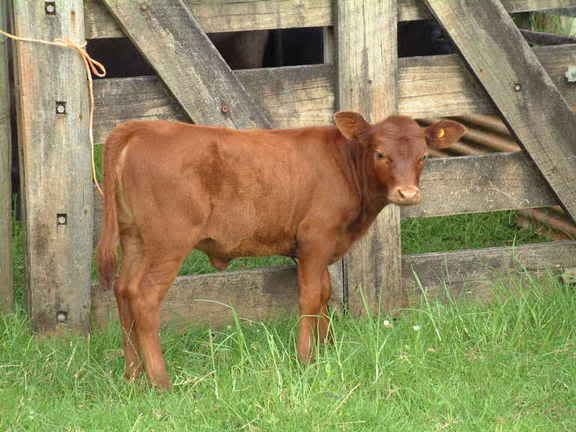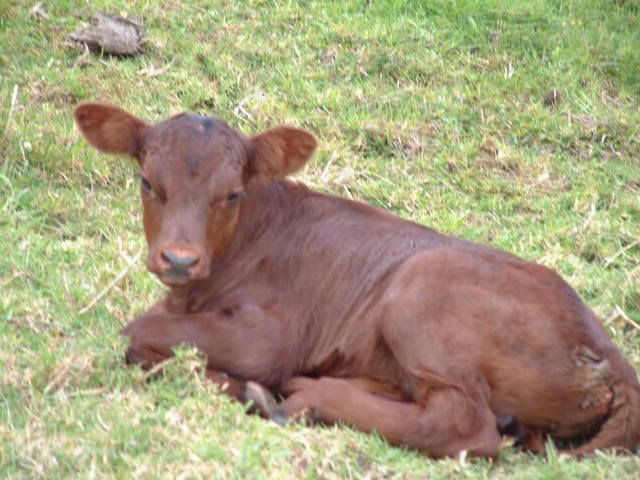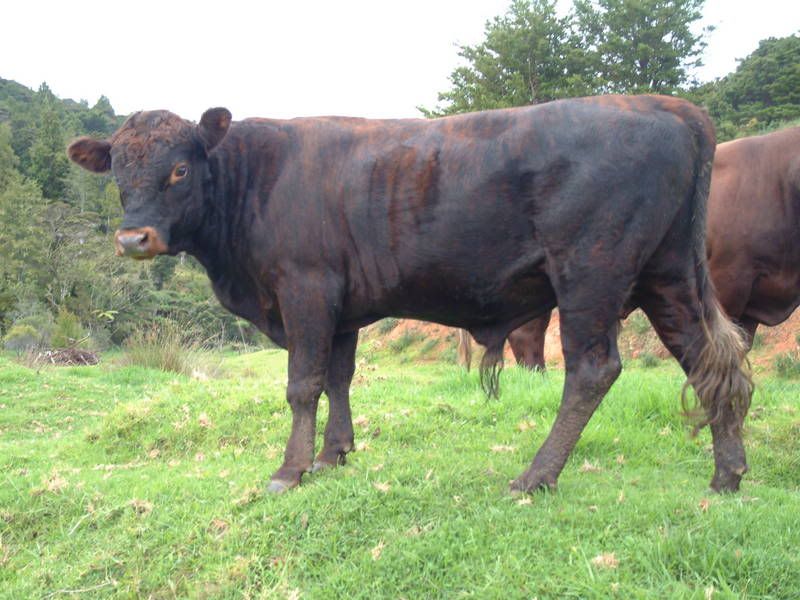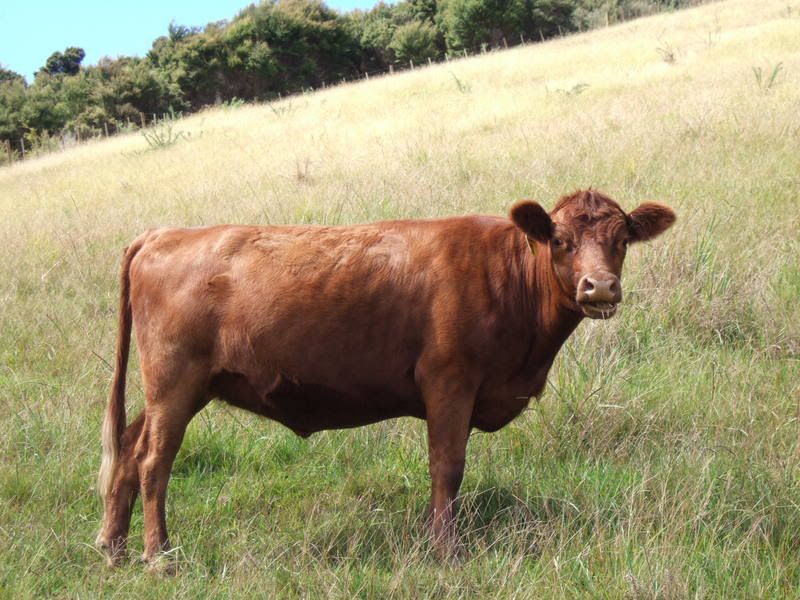dun
- Broomcroft
- Posts: 3005
- Joined: Wed Sep 06, 2006 4:42 am
- Location: Shropshire, England
- Contact:
Hi Kirk
No, Joseph the bull hasn't been colour tested but he has been tested as a non-carrier. However, we have had 30 calves by him in the last 6 months, and the little red-black one, Emile, was unique and a result of the cow I feel.
He sires a lot of reds, 10 out of 30. In fact, I'd have to go through my records, but I think it's true to say that if the black cow throws red and black, and I only know that from history, then he has produced a red calf. I'll have to check my details though.
I have some red cows as well, very few though, and they have produced red calves by him, which I understand is what should happen. Even when the red dam is not totally red, the calf is.
All red calves are 100% red, not a sign of black anywhere really, except one where the dam has a slightly black face and so does the calf. His red calves have varying degrees of pink noses from grey-pink, to totally pink. He has also thrown some really jet-black calves. So is he true-red on that basis?
Note that all his red calves are female except one out of 11 in total that I have overall. I know this is just chance but it does make it very easy when sorting them into groups :p.
Would it be worth having him DNA colour-tested? What does it cost, what would be the benefit?
No, Joseph the bull hasn't been colour tested but he has been tested as a non-carrier. However, we have had 30 calves by him in the last 6 months, and the little red-black one, Emile, was unique and a result of the cow I feel.
He sires a lot of reds, 10 out of 30. In fact, I'd have to go through my records, but I think it's true to say that if the black cow throws red and black, and I only know that from history, then he has produced a red calf. I'll have to check my details though.
I have some red cows as well, very few though, and they have produced red calves by him, which I understand is what should happen. Even when the red dam is not totally red, the calf is.
All red calves are 100% red, not a sign of black anywhere really, except one where the dam has a slightly black face and so does the calf. His red calves have varying degrees of pink noses from grey-pink, to totally pink. He has also thrown some really jet-black calves. So is he true-red on that basis?
Note that all his red calves are female except one out of 11 in total that I have overall. I know this is just chance but it does make it very easy when sorting them into groups :p.
Would it be worth having him DNA colour-tested? What does it cost, what would be the benefit?
Clive
-
wagra dexters
- Posts: 591
- Joined: Thu Mar 31, 2005 11:49 am
- Location: Australia
- Contact:
Thanks for the pedigree, Clive. I have taken it back two more generations, to more familiar ground.
The cow's suspected red gene has been travelling incognito for a few generations, but further investigation is bound to expose the source.
Stew, so much for the simple question about dun! Our few duns all fall into the Woodmagic-type category of the herd. Chasing red has compromised size, so they fit into the 'Work in Progress' category, but that will sort out in time.
I love the camouflage of the dun, which may not work so well on lush green English pastures.
Margaret.
The cow's suspected red gene has been travelling incognito for a few generations, but further investigation is bound to expose the source.
Stew, so much for the simple question about dun! Our few duns all fall into the Woodmagic-type category of the herd. Chasing red has compromised size, so they fit into the 'Work in Progress' category, but that will sort out in time.
I love the camouflage of the dun, which may not work so well on lush green English pastures.
Margaret.
Graham Beever & Margaret Weir
http://www.wagra-dexter.com.au/
http://www.wagra-dexter.com.au/
-
Kirk- Cascade Herd US
- Posts: 267
- Joined: Tue Aug 29, 2006 7:21 am
Joseph's siring of lots of reds is due to the cows, not the bull. Since he has two copies of the red genes, he must always give a red gene, there's no other choice. All of your black cows that have have had a red calf have one black gene (ED) and one red gene (either E+ or Ee). When those red-carrying black cows prepare an egg for that cycle, that egg has a single primary color gene, either mom's black gene or mom's red gene (50/50 chance). So even before your red bull has done the job, the color of the calf, in the case of your red-carrying black cows, has already been determined via the egg preparation process.Broomcroft wrote:Hi Kirk
No, Joseph the bull hasn't been colour tested but he has been tested as a non-carrier. However, we have had 30 calves by him in the last 6 months, and the little red-black one, Emile, was unique and a result of the cow I feel.
He sires a lot of reds, 10 out of 30. In fact, I'd have to go through my records, but I think it's true to say that if the black cow throws red and black, and I only know that from history, then he has produced a red calf. I'll have to check my details though.
I have some red cows as well, very few though, and they have produced red calves by him, which I understand is what should happen. Even when the red dam is not totally red, the calf is.
All red calves are 100% red, not a sign of black anywhere really, except one where the dam has a slightly black face and so does the calf. His red calves have varying degrees of pink noses from grey-pink, to totally pink. He has also thrown some really jet-black calves. So is he true-red on that basis?
Note that all his red calves are female except one out of 11 in total that I have overall. I know this is just chance but it does make it very easy when sorting them into groups :p.
Would it be worth having him DNA colour-tested? What does it cost, what would be the benefit?
If Joseph (a homozygous red) is bred to an ED/ED (homozygous black) then 100% of that cow's calves will be black and will have one of mom's two black genes, and 100% will carry one of dad's two red genes.
The difference between the Ee (recessive true red gene) and E+ (wild-type red gene) is that the wild-type red allows other shading control genes to work with black pigments to shade the otherwise red animal, while the true red gene (Ee) allows only red pigment with no black shading/pigment. So an unshaded wild-type red can look exactly like a true red, or can go rather black depending on the shading/patterning genetics that the wild-type red has. A homozygous true red (Ee/Ee) is always 100% red because the chemistry of Ee/Ee does not allow black pigment production.
It is impossible to tell for certain whether your bull is E+/Ee or Ee/Ee (without DNA testing), but I'm theorizing that he is E+Ee based on the one dark red calf that I'm theorizing is E+E+. However, that dark red calf could be E+Ee and dad could be EeEe, but I'm certain that the mother is EDE+
In North America, red (and polled) carries a premium right now mostly due to their rarity and due to fads. Also, some scientists are stating that red or black have advantages in certain climates due to heat adaptability, some saying that red has advantages over black in much of the warmer areas. Many breeders who understand the difference between E+ and Ee want to know which of these two red gene choices their AI bull, or purchased bull (or cow) carries. Some are marketing their Ee/Ee reds as "true reds" for a premium.
In my farm's case, we like the true reds because they breed true and always throw consistent red color, rather than a rainbow of reds, some with black noses, some with pink, some with light bodies, some with dark. Other farms like the wild-type red just for the opposite reason - they like the idea of exploring all of the ranges of color in Dexters.
The advantages you would have in knowing your bull's primary color genotype are 1. Satisfaction of curiosity and 2: Be able to provide a potential buyer with some genetic info - for example if I was buying a black heifer out of Joseph from you I would want to know if that heifer carried an E+ or Ee red gene because I'm focusing on Ee. Now, perhaps that isn't the case in the UK and no one there cares about it.
Hope this helps,
Kirk
- Broomcroft
- Posts: 3005
- Joined: Wed Sep 06, 2006 4:42 am
- Location: Shropshire, England
- Contact:
Kirk
That's very clear and many thanks for taking so much trouble with your explanation. I am going to make enquiries about getting Joseph colour tested via the UK society. I actually don't know the situation with red's in the UK but we certainly like them on our farm quite simply because of the colour, which is partially why we went for Joseph.
Thanks again.
That's very clear and many thanks for taking so much trouble with your explanation. I am going to make enquiries about getting Joseph colour tested via the UK society. I actually don't know the situation with red's in the UK but we certainly like them on our farm quite simply because of the colour, which is partially why we went for Joseph.
Thanks again.
Clive
-
Kathy Millar
- Posts: 725
- Joined: Wed May 19, 2004 4:53 pm
- Location: Vancouver Island, BC, Canada
Those black-nosed reds are sure different. If I hadn't been reading this thread, I would have been tempted to call the black-nosed red animals "dun". I have never seen anything but pink skin in my reds and I have a nice polled red heifer right now out of Saltaire Platinum that I will have to sell due to keeping the herd smaller. Kirk, have you heard of any breeding stock coming across the Border yet?
Kathy
Home Farm, Vancouver Island, Canada
Home Farm, Vancouver Island, Canada
-
Kirk- Cascade Herd US
- Posts: 267
- Joined: Tue Aug 29, 2006 7:21 am
I agree that in the top picture, the calf is probably homozygous true-red (two true red genes, Ee/Ee) but it could very likely also be heterozygous Ee/E+ (one true red, and one wild-type red gene) and lacks the dark skin/dark nose shading gene which is somewhat effective even with only one E+ gene. It is also remotely possible, but improbable that the top calf is E+/E+ (homozygous wild-type) and has shading genes that specifically turn off all the black pigments provided by the E+, so only the red pigment (phaeomelanin) provided by E+ is used and none of the black/brown pigment (eumelanin) provided by E+ is used. The only way to know for sure would be to DNA color test.
The bottom calf with the dark nose definitely has at least one E+ wild type gene because at least one E+ gene is needed to make the black nose/skin gene effective. I would guess that this calf is not E+/Ee but is E+/E+ because it looks like it has a lot of black shading in its coat and that is usually the result of two E+ genes, in conjunction with other (unknown) shading genes.
So, to sum up. Ee true red genes can only give you a true red look while E+ wild-type red can give you almost any shade and pattern.
The bottom calf with the dark nose definitely has at least one E+ wild type gene because at least one E+ gene is needed to make the black nose/skin gene effective. I would guess that this calf is not E+/Ee but is E+/E+ because it looks like it has a lot of black shading in its coat and that is usually the result of two E+ genes, in conjunction with other (unknown) shading genes.
So, to sum up. Ee true red genes can only give you a true red look while E+ wild-type red can give you almost any shade and pattern.
- Broomcroft
- Posts: 3005
- Joined: Wed Sep 06, 2006 4:42 am
- Location: Shropshire, England
- Contact:
Inger - Pictures are fine on my machine.
Stew - Look at the www.dextercattleforsale.co.uk site itself or through the herds near you. Available on the www.dextercattle.co.uk society web site.
Stew - Look at the www.dextercattleforsale.co.uk site itself or through the herds near you. Available on the www.dextercattle.co.uk society web site.
Clive
-
Kirk- Cascade Herd US
- Posts: 267
- Joined: Tue Aug 29, 2006 7:21 am
The Photos are excellent! :D
Next question---how does the brindle or black nosed red fit in with the standard?
Would it be disqualified in a show?
If it is registered as red as a youngster and then turns black /brindle do you change the registration details.
BTW the brindle is a most attractive beast.
Cheers Louise
Next question---how does the brindle or black nosed red fit in with the standard?
Would it be disqualified in a show?
If it is registered as red as a youngster and then turns black /brindle do you change the registration details.
BTW the brindle is a most attractive beast.
Cheers Louise
The brindle animal was steered and sold at the sales yard as a 2 year old. We can't registered brindle Dexters, so if it had been registered before the brindling showed up, it would have to be de-registered I should imagine. I would have to ask the Herd Registraar to see if he knows of any such cases.
True, its not possible to show an unregistered Dexter at our cattle shows and the judges would disqualify such an animal from entering the competitions as it is against the breed standard.
True, its not possible to show an unregistered Dexter at our cattle shows and the judges would disqualify such an animal from entering the competitions as it is against the breed standard.
Inger
NZ
NZ



